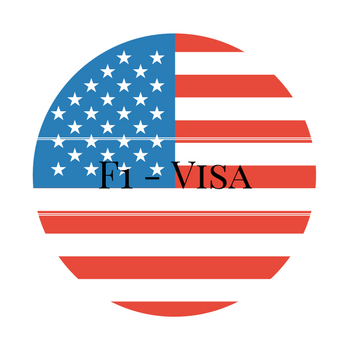
Reference: Wikipedia
F-1 – VISA
In the United States, the F visas are a type of non-immigrant student visa that allows foreigners to pursue education (academic studies and/or language training programs) in the United States. F-1 students must maintain a full course of study.[1] F-1 visas are only issued in U.S. embassies and consulates outside the United States, although extensions of stay and changes of status may be possible within the United States.[2] Prospective F-1 students must apply at the schools and receive a form I-20 in order to apply for an F-1 visa.[2][3] F-1 students must show that they are able to support themselves during their stay in the U.S., as their opportunities for legal employment are quite limited.[4] F-2 visas are given to dependents of an F-1 student. F-2 visa-holders are prohibited from any form of compensated employment. However, minor children may attend public schools.[5] Finally, the F-3 visa is issued to Canadians and Mexicans who commute across the border to attend American schools.
To pursue studies in F status at a college, university, or vocational school, it is necessary that the institution be a participant in the Student and Exchange Visitor Program (SEVP). An institution can acquire SEVP certification by filing Form I-17 with U.S. Immigration and Customs Enforcement (this is a one-time process).[8] An institution can be SEVP-certified despite not holding national or regional accreditation.[9] Conversely, an institution may hold national or regional accreditation but may have chosen not to obtain SEVP certification if it does not intend to admit international students in the F, J, or M status.
A large university typically has an international office that manages its participation in the SEVP, and all the designated school officials (DSOs) work for this office. The international office manages updates to the Student and Exchange Visitor Information System (SEVIS) record for students and issuing of new Form I-20s. Students who have any change to their plans (such as program end date, course load, leave of absence, return from leave of absence) must communicate these changes with their international office.
It is possible to obtain an F-1 visa to pursue studies at a secondary school (grades 9-12). As is the case with other institutions, the secondary school must be SEVP-certified. The school may be a public (government-funded) school or a private school. In the case of a public school, the student may attend for a maximum period of 12 months and must reimburse the school for the full per-capita cost of attendance. Neither of these requirements apply for students attending private schools.[10]
The Form I-94 that is issued to F-1 students upon arrival is generally annotated “D/S” indicating duration of status, which means that the student can stay in the United States as long as he/she is in valid student status. In addition, there is a grace period of 60 days after the completion of studies to depart the United States.[20][26][27]
The exception to “D/S” is in cases where the student’s documentation is not considered complete or satisfactory by the officer at the port of entry. In this case, the expiration date on the Form I-94 is listed as thirty days from the present date, and the student is issued Form I-515A, indicating what information was missing from the student’s documentation. The student must contact his or her international office for help with obtaining the correct documentation.[28][29]
Under ordinary conditions (i.e., unless any exceptions apply) a student must, in order to maintain valid student status:
- maintain a “full course load” (unless the institution approves the student for a Reduced Course Load)
- not be engaged in any employment without authorization of Department of Homeland Security
- have an accurate SEVISrecord, and in particular, should not be past the program end date indicated on the Form I-20.
The SEVIS regulations stipulate one requirement for staying in status as being that the student must maintain a full course load, defined as 12 or more credit hours for credit-bearing schools and 18 or more contact hours for intensive English program enrollment. However, the precise translation of the requirement in terms of the structure of courses at a particular institution may vary by institution.
The following are the accepted reasons for having a reduced course load in a given quarter or semester
- Final quarter or semester, where only a partial course load is needed to meet graduation requirements (this can be availed at most one time)
- Medical condition (this can be availed at most four times)
- Academic difficulty (this can be availed at most one time). Three types of reasons are allowed:
- Initial difficulty with the English language or reading requirements
- Unfamiliarity with U.S. teaching methods
- Improper course level placement
Reduced Course Load must be applied for in advance so that the SEVIS record can be updated and a new Form I-20 noting the Reduced Course Load can be issued.
On August 27, 2002, an Interim Final Rule was issued extending Reduced Course Load to border commuter students (one of the measures that was part of the introduction of the F-3 status); this was a complementary measure to the phasing out of the use of B visas for study.[32]
Unless approved for practical training, a person in student status may only engage in on-campus employment.[33] On-campus employment may include:[33][34]
- Employment by the institution, for instance, as a teaching assistant, research assistant, or library student worker
- Work performed in a location on campus for a commercial firm providing direct services to students, for instance, at a campus bookstore even if not owned by the university
- Employment at an off-campus location that is educationally affiliated with the institution. The work must be associated with the academic department’s curriculum, related to contractually funded projects at the post-graduate level, and integral to the curriculum.
There are also limits on the amount of time a student may engage in on-campus employment. While school is in session, this can be no more than 20 hours per week. While school is out of session, there are no restrictions on the amount of work.[34]
There are two primary ways a person in student status may be able to legally qualify for off-campus employment, namely Curricular Practical Training and Optional Practical Training. Both of these need to be approved by the institution and included in the student’s SEVIS record and Form I-20. Within Optional Practical Training, there is both pre-completion and post-completion Optional Practical Training.
A student in F-1 status is not allowed to engage in on-campus employment during the 60-day grace period after completion of studies. Moreover, while the student is on post-completion Optional Practical Training, the student can only engage in the type of employment permitted by that Optional Practical training, and therefore cannot engage in arbitrary on-campus work.
An F-1 student who experiences severe economic hardship due to unforeseen circumstances beyond the student’s control, the student may request employment authorization to work off-campus under certain circumstances.[35] Examples of unforeseen circumstances that may be eligible include loss of financial aid due to no fault of the student, loss of on-campus employment through no fault of the student, substantial fluctuations in currency value or exchange rate, inordinate increases in tuition or living costs, unexpected changes in the financial condition of the student’s source of support, and substantial unexpected medical bills.[35] The student must have been in F-1 status for one full academic year, be a student in good standing, and be carrying a full course of study.[36] Off-campus employment must not interfere with the student’s full-time studies and the employment is necessary to avoid severe economic hardship.[36] A student experiencing such a severe economic hardship due to unforeseen circumstances may request employment authorization by sending Form I-765, a copy of the student’s Form I-20 including the employment page completed by the designated school official, and documentation of the severe economic hardship due to unforeseen circumstances to U.S Citizenship and Immigration Services.[35] If U.S. Citizenship and Immigration Services approves the request, the student may work off-campus in one-year intervals up to the expected date of completion the student’s current course of study.[35]
Over and above the rules imposed on account of F student status, the student and employer must also comply with all existing federal, state, and local regulations pertaining to wages, working conditions, and tax law. For instance, the student may need to obtain a Social Security Number in order to be able to engage in on-campus work, and employers may ask the student to fill Form I-9 at the start of employment.[34]
The F status does not explicitly recognize Leave of Absence. Rather, if somebody intends to take a lengthy leave of absence, then their institution terminates their SEVIS record for “Authorized Early Withdrawal”. There is a 15-day grace period to depart the United States on such a terminated record.[37] If the student then returns in 5 months or fewer, the F-1 status can be reactivated with the same I-20 and without any effect on OPT/CPT eligibility (this has a lead time of up to a month). If more than 5 months elapse, a new SEVIS record must be created for the student, with a new Form I-20.[38][39]
Physical absence from the United States for a contiguous period of over five months automatically deactivates one’s student status, even if the student did not explicitly request termination of the SEVIS record.[39]
It may happen that the student’s actual program end date falls earlier or later than what the student expected. It is necessary that a new I-20 be issued reflecting the current program end date, both prior to the program’s actual end and prior to the stated program end date on the Form I-20.
If the Form I-20 is being shortened, the international office may require the student to submit evidence showing that the student has enough academic credits to graduate early.[40] If the Form I-20 is being extended, then, in addition to any evidence from the student about changed academic plans, the international office also needs an updated statement of financial resources for the new I-20 to cover up to one year of the I-20 extension.
After the change to the program end date is made in the student’s SEVIS record, the new Form I-20 is issued to the student.
The program end date on the Form I-20 need not coincide with the graduation date. Rather, it is the end date of the student’s enrollment in courses. It is not possible to extend the program end date simply in order to be able to stay around till the graduation ceremony. If the graduation ceremony falls outside the 60-day grace period of completion of coursework, then the student must find some other way to be legally present for it (for instance, by staying around on Optional Practical Training, or getting a B visa for the graduation ceremony).[40]


